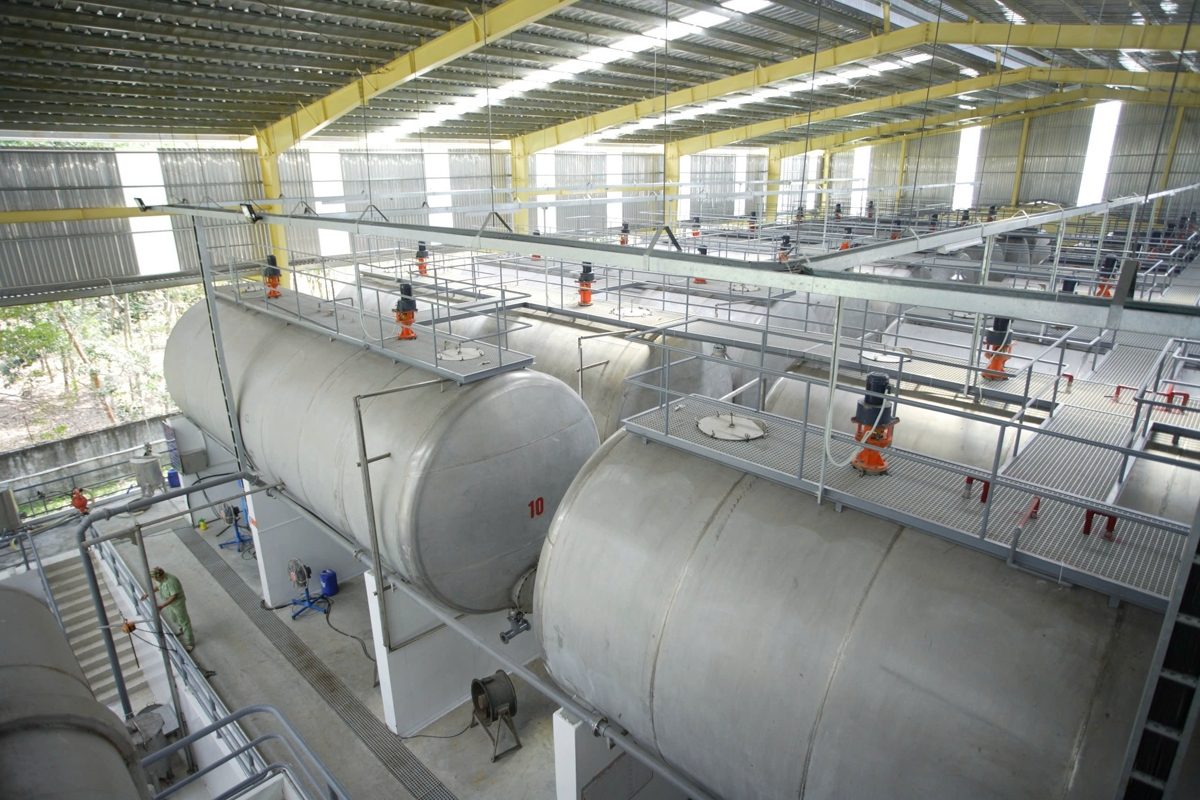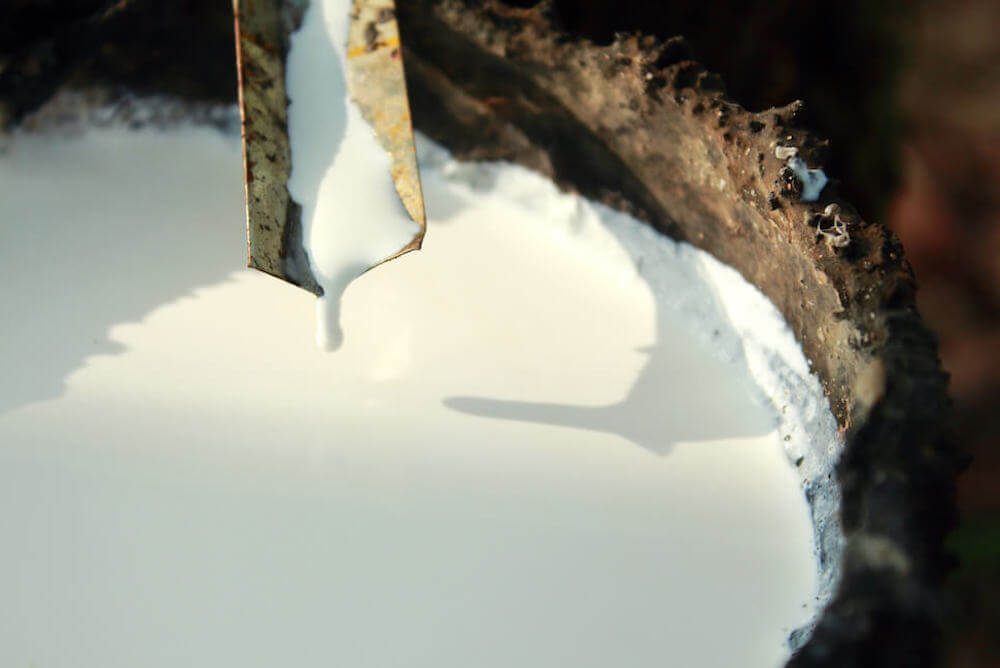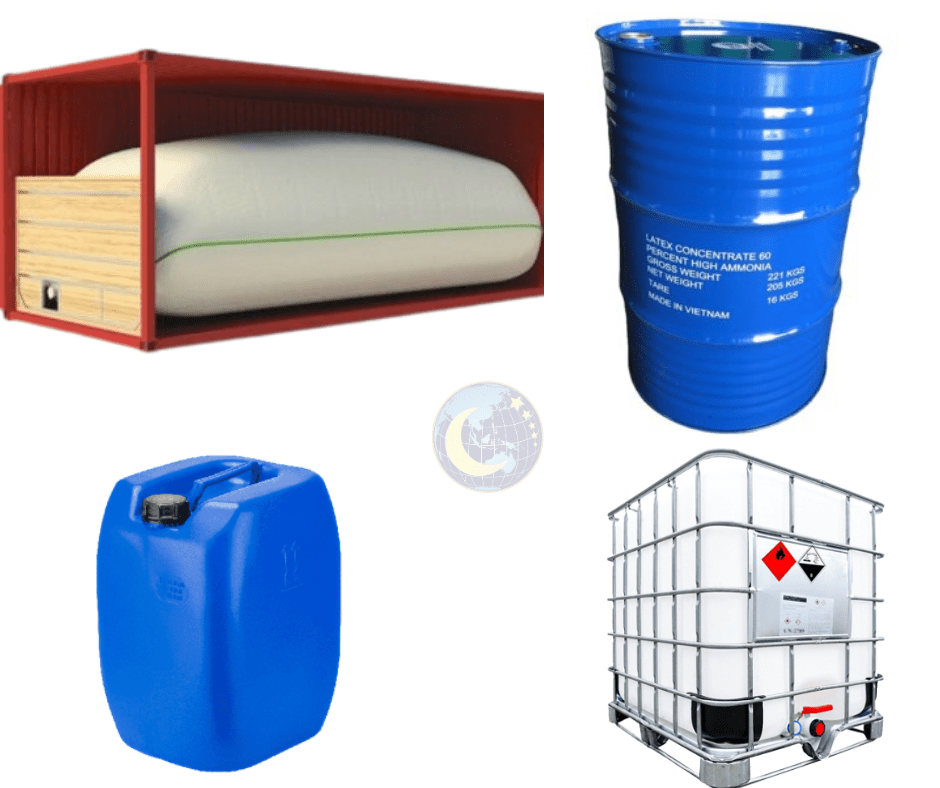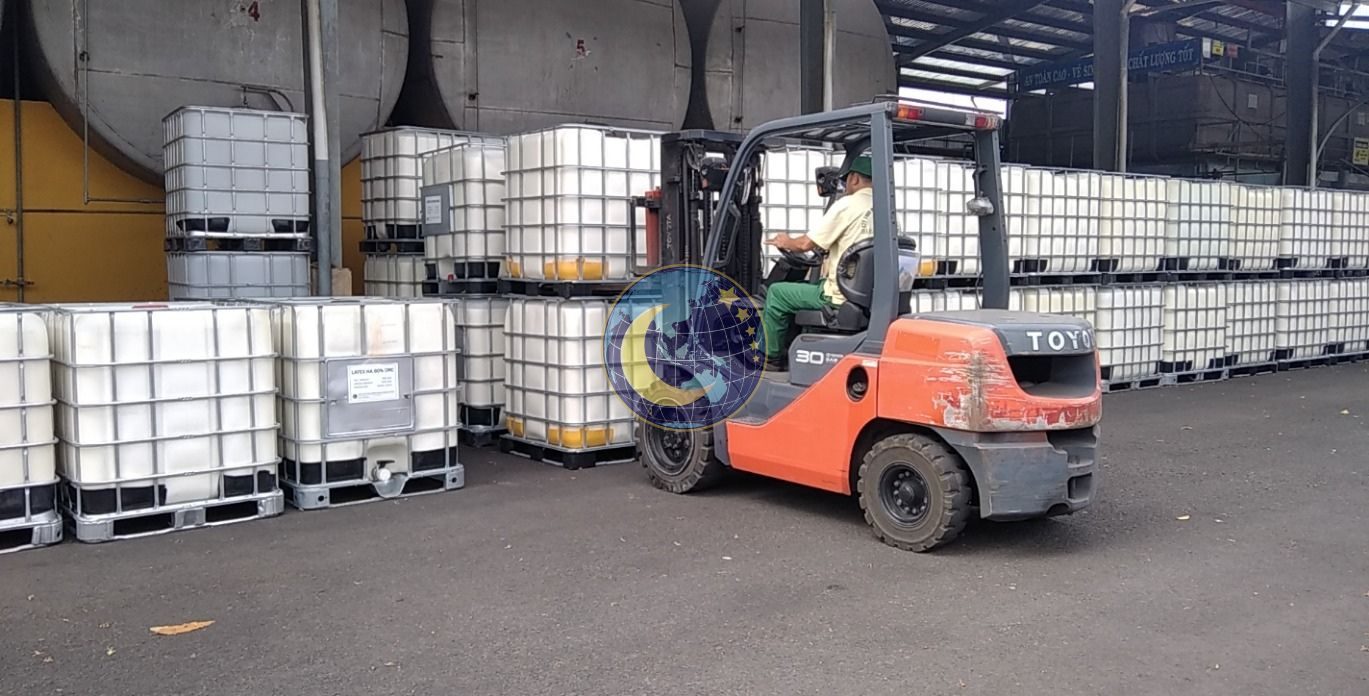Contents
- 1 Why Proper Preservation of Natural Rubber Latex 60% DRC is Important
- 2 Optimal Storage Conditions for Natural Rubber Latex 60% DRC
- 3 Packaging and Containers for Latex Preservation
- 4 Steps to Preserve Natural Rubber Latex Effectively
- 5 Common Mistakes in Latex Storage and How to Avoid Them
- 6 Tools and Equipment for Effective Latex Preservation
- 7 8. Why Choose Ngoc Chau’s Expertise in Latex Preservation?
Natural Rubber Latex 60% DRC stands as a vital raw material across numerous industries, including medical, automotive, and adhesives. Its remarkable elasticity, durability, and eco-friendly attributes render it indispensable for the manufacturing of gloves, mattresses, adhesives, and a wide array of other products. However, inadequate storage practices can significantly compromise its quality, leading to financial losses and production inefficiencies.
The proper preservation of this latex is paramount to maintaining its usability and ensuring adherence to stringent industry standards. This guide will delve into the most effective practices for storing Natural Rubber Latex 60% DRC, with the aim of maximizing its shelf life and overall performance.
Why Proper Preservation of Natural Rubber Latex 60% DRC is Important
Natural Rubber Latex 60% DRC (Dry Rubber Content) is an indispensable raw material that underpins a vast array of industries, including the medical sector (in the production of gloves, catheters, and medical tubing), the automotive industry (for tires, seals, and hoses), and the adhesives and sealants market. Its unique combination of high elasticity, exceptional durability, and environmentally friendly characteristics makes it a preferred choice for manufacturing a wide spectrum of products, from comfortable mattresses and resilient footwear to high-performance industrial components.
However, the inherent properties of Natural Rubber Latex 60% DRC make it susceptible to degradation if not stored under optimal conditions. Improper storage can trigger a cascade of negative effects that directly impact the quality of the raw material, leading to significant financial losses through spoiled batches and substantial production inefficiencies due to material that no longer meets required specifications.
- Degradation and Vulcanization: Exposure to extremes of temperature, particularly excessive heat, or prolonged exposure to direct sunlight can initiate premature hardening or even vulcanization of the latex. This alters its intended physical properties, reducing its elasticity and making it unsuitable for its intended applications. Such degradation can render entire batches of latex unusable.
- Proliferation of Bacterial Growth: Natural Rubber Latex is an organic material, making it vulnerable to microbial contamination. Without the inclusion of appropriate preservatives or storage in properly sealed, airtight containers, bacteria and other microorganisms can proliferate within the latex. This bacterial growth can alter the chemical composition of the latex, affecting its viscosity, stability, and overall performance. In severe cases, it can lead to the formation of foul odors and render the latex unusable.
- Clumping and Coagulation: Fluctuations in humidity levels, especially elevated humidity, can introduce moisture into the latex. This excess moisture can disrupt the delicate colloidal stability of the latex particles, leading to unwanted coagulation or clumping. Once coagulation occurs, the latex becomes a viscous, lumpy mass that is extremely difficult, if not impossible, to process effectively in manufacturing processes. This results in material waste and production downtime.
The Tangible Benefits of Implementing Proper Preservation Practices:
- Extended Shelf Life and Material Longevity: Implementing correct storage protocols significantly extends the usable shelf life of Natural Rubber Latex 60% DRC. When stored under optimal conditions, the latex can remain stable and retain its desired properties for up to a year or even longer, minimizing material spoilage and reducing the frequency of costly restocking.
- Maintenance of Optimal Quality and Performance: Proper preservation actively prevents undesirable changes in the latex’s critical performance characteristics. This includes maintaining its essential elasticity, ensuring the correct viscosity for processing, and preserving its overall performance capabilities, guaranteeing the quality of the end products manufactured using this raw material.
- Ensuring Regulatory Compliance and Quality Assurance: Adhering to best practices in latex storage helps businesses meet stringent international quality standards, such as ISO 9001. This commitment to quality assurance not only enhances the reliability of their products but also builds trust with customers and stakeholders, facilitating smoother regulatory compliance and market access.
Optimal Storage Conditions for Natural Rubber Latex 60% DRC
Temperature Control
Improper storage of Natural Rubber Latex 60% DRC can lead to several detrimental issues. Exposure to extreme temperatures or direct sunlight can cause degradation, resulting in hardening or unwanted vulcanization of the latex. Furthermore, the absence of appropriate preservatives or airtight containers can foster bacterial growth, compromising the integrity of the material. High humidity levels pose another risk, potentially causing clumping or coagulation that renders the latex unusable.
Ideal Temperature Range: Maintaining Natural Rubber Latex 60% DRC within the temperature range of 15°C to 30°C (59°F to 86°F) is crucial.
Impact of Inappropriate Temperatures: It is particularly important to avoid freezing the latex (below 0°C or 32°F) or allowing it to become excessively hot (above 35°C or 95°F), as these conditions can cause irreversible damage such as vulcanization or hardening, thereby destroying the inherent properties of the latex.
Temperature Control Solutions: To ensure a stable temperature within storage facilities, the use of air conditioning or heating systems is recommended, depending on the external environmental conditions.
Humidity Control
Ideal Relative Humidity Range: For optimal preservation of Natural Rubber Latex 60% DRC, it is essential to maintain relative humidity levels between 50% and 60%.
Impact of Inappropriate Humidity: Controlling humidity within this range is particularly important to prevent the growth of mold, which can degrade the quality of the latex, and to avoid coagulation, which renders the latex unusable.
Humidity Control Solutions: To achieve and maintain the ideal humidity levels within storage areas, the use of dehumidifiers or the placement of desiccants such as silica gel packs is recommended.
Light Exposure
Exposure to direct sunlight and UV radiation can trigger chemical reactions within the natural rubber latex, leading to the degradation of the material over time. Store natural rubber latex in a dark environment, away from direct sunlight or any source of UV (ultraviolet) light exposure.
Packaging and Containers for Latex Preservation
Types of Containers for Storing Latex:
Selecting the appropriate type of packaging and containers plays a crucial role in maintaining the quality of Natural Rubber Latex 60% DRC during storage and transportation. Here are the common types of containers used.
Types of Containers for Storing Latex:
- Flexibags: Ideal for bulk transport (20 MT capacity). Advantages include reduced transportation and storage costs compared to rigid containers.
- Drums: Suitable for smaller quantities (200 kg per drum). Easy to handle and move within storage facilities.
- IBC Tanks: Best for long-term storage (960 kg per tank). Provide good protection and are stackable for space efficiency.
- Jerry Cans: Convenient for small-scale use (25 kg per can). Often used for laboratory applications or small-batch production.
Key Recommendations
- Utilize airtight containers to prevent external contamination and minimize water evaporation from the latex, thereby preserving its concentration and quality.
- Prioritize containers made from lined mild steel or aluminum to avoid corrosion that can occur during prolonged storage, especially with latex types containing ammonia.
Steps to Preserve Natural Rubber Latex Effectively
- Preparation Before Storage: Ensure containers are clean and dry before filling with latex. Add ammonia preservative (0.6%–0.8%) for High Ammonia Latex (HA) to inhibit bacterial growth.
- Daily Monitoring: Regularly check temperature and humidity levels using monitoring devices. Inspect containers for leaks or signs of contamination.
- FIFO Principle: Implement the “First In, First Out” inventory system to use older batches first.
- Periodic Maintenance: Conduct monthly inspections of stored batches for signs of mold, clumping, or discoloration.
- Handling During Transportation: Use insulated totes or heated blankets during shipping to maintain optimal conditions.
Common Mistakes in Latex Storage and How to Avoid Them
The proper storage of Natural Rubber Latex 60% DRC is a critical factor in maintaining its quality and performance throughout its intended use. However, several common mistakes can occur during the storage process, leading to negative consequences. Recognizing and proactively avoiding these errors will help businesses minimize losses and ensure their raw materials remain in optimal condition.
Mistakes in preserving natural rubber:
-
Storing latex in fluctuating temperatures leading to condensation inside containers:
Continuous temperature variations within the storage facility can create a temperature differential between the air inside and outside the containers. When the temperature drops, moisture in the humid air can condense on the inner walls of the containers. This condensation can dilute the latex, alter the DRC (Dry Rubber Content), and create a favorable environment for the growth of microorganisms, particularly mold and bacteria, thus degrading the latex quality.
Consequences: Reduced viscosity, altered mechanical properties, increased risk of contamination, and a shortened shelf life of the latex. - Using unlined steel tanks that can react chemically with the latex:
Expansion: Ordinary steel, especially carbon steel, can react with the chemical components in latex, particularly the ammonia often used as a preservative. This reaction can cause corrosion of the metal, releasing metal ions into the latex, which can alter its color, viscosity, and even cause premature coagulation of the latex.
Consequences: Reduced latex quality, potential damage to large batches, and increased waste disposal costs. - Exposing containers to sunlight or UV light that degrades the material’s properties:
Expansion: Direct sunlight, especially ultraviolet (UV) radiation, carries high energy that can break down the polymer chains in latex. This process, known as photodegradation, leads to the deterioration of critical physical properties of the latex, such as elasticity, tensile strength, and elongation. The surface of the latex directly exposed to light can become brittle, cracked, and lose its inherent functionality.
Consequences: End products with poor quality, increased susceptibility to failure, and failure to meet technical standards.
Some solutions to preserve natural rubber:
- Invest in climate-controlled storage facilities: Maintain stable temperature and humidity levels to prevent condensation, microbial growth, and unwanted chemical reactions.
- Use lined tanks or aluminum containers for long-term storage: Avoid corrosion and chemical reactions between the latex and the container material.
- Regularly inspect storage conditions and equipment performance: Ensure the climate control system is operating effectively and detect potential issues that could affect latex quality early on.
Implementing these solutions plays a crucial role in preserving the quality of natural rubber latex, extending its shelf life, and minimizing risks during storage.
Tools and Equipment for Effective Latex Preservation
The use of appropriate tools and equipment plays a crucial role in maintaining optimal storage conditions for Natural Rubber Latex 60% DRC. Here are some essential pieces of equipment:
- Dehumidifiers: Used to maintain optimal humidity levels within the warehouse, preventing mold growth and coagulation.
- Temperature Control Devices: Including air conditioning and heating systems, these devices monitor and stabilize temperature fluctuations, ensuring the latex does not become excessively hot or cold.
- Storage Shelves: Help elevate latex containers off the floor, preventing direct contact with moisture and dirt, while also allowing for even air circulation around them to maintain a stable temperature.
- Heated blankets or insulation wraps: Utilized during transportation, especially in extreme weather conditions, to maintain a stable temperature for the latex and prevent freezing or overheating.
Investing in and effectively using these tools and equipment will significantly contribute to preserving the quality of natural rubber latex throughout the storage and transportation processes.
8. Why Choose Ngoc Chau’s Expertise in Latex Preservation?
Ngoc Chau stands out as a trusted supplier of Natural Rubber Latex 60% DRC due to its profound expertise in advanced preservation techniques:
Commitment to Quality:
- Premium-grade Natural Rubber Latex sourced from certified plantations, ensuring superior origin and quality.
- Strict adherence to international standards such as ISO 9001 guarantees consistent product quality that meets the most demanding requirements.
Sustainable Practices:
- Implementation of environmentally friendly production methods, demonstrating responsibility towards the community and aligning with global sustainability goals.
Professional Service:
- Provision of specialized technical support, tailored to the specific needs of each customer, ensuring the most effective use and preservation of latex.
- Flexible packaging options such as drums or flexibags are designed to guarantee absolute product stability throughout the transportation process, whether by land, sea, or air.
Proven Track Record:
- Ngoc Chau is proud to be a trusted partner to numerous clients worldwide, operating in key industries such as medical glove manufacturing, mattresses, adhesives, and automotive parts production. This trust is clear evidence of our superior product quality and exceptional service.
Preserving Natural Rubber Latex 60% DRC effectively is essential for maintaining its quality and ensuring optimal performance in manufacturing processes. Proper temperature control, airtight packaging, regular monitoring, and adherence to best practices are key factors that extend its shelf life while minimizing risks of degradation.
Partnering with a reliable supplier like Ngoc Chau ensures access to high-quality latex solutions backed by professional preservation practices and sustainable production methods. Contact Ngoc Chau today for premium-grade Natural Rubber Latex tailored to your business needs.
📩 Contact Us for Latex 60% DRC Samples & Pricing
📞 WhatsApp: +84 90 284 60 87
🌐 Website: www.ngocchausupplier.com
✉ Email: info@ngocchausupplier.com














 Ms Evan
Ms Evan